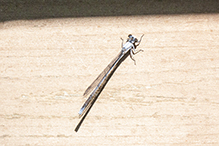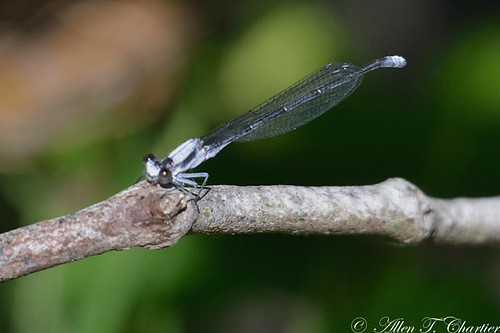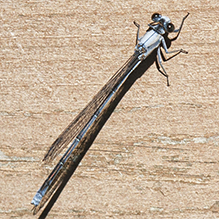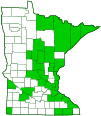powdered dancer
(Argia moesta)
Conservation • Description • Habitat • Ecology • Distribution • Taxonomy
|
|
|||||||||||||
Description |
Powdered dancer is a common and widespread, medium to large sized damselfly. At 1½″ to 1¾″ it is the largest dancer damselfly (genus Argia) and the largest narrow-winged or pond damselfly (family Coenagrionidae). Unlike American bluets (genus Enallagma) dancers are easy to identify in the field by their colors and the pattern of their markings. The thorax on immature males is tan with two broad, dark stripes on the upper (dorsal) surface. It becomes dark brown with age. On older males it is almost completely covered with a chalky white, waxy substance (pruinescence). The abdomen is brown on young males except for a dorsal pale area on segment 1 and a narrow pale ring at the base of segments 3 through 7. Segments 9 and 10 are pale gray. The base color darkens with age, becoming almost black on older individuals. On the male there are two pairs of claspers at the tip of the abdomen. The upper pair (cerci) are shorter than the lower pair (paraprocts). On the female there is no vulvular spine on the lower part of abdominal segment 8. The wings are clear and are distinctly narrowed (stalked) at the base. The stigmas are short, less than twice as long as wide, and there are two cells below the stigma. There are only two cross veins between the base of the wing and the wing notch (nodus). The median vein intersection, where the M3 vein rises to meet the M1 vein, occurs after the nodus, closer to the nodus than the basal cross vein (arculus). The legs are short, pale, and armed with spines. The spines on the lower leg (tibia) are long, twice as long as the space between the spines. The female has two color forms, one with a brown thorax, the other with a blue thorax. The shoulder stripes are hair thin. The abdomen is brown with a wide, pale dorsal stripe and narrow, dark lateral stripes. |
SizeTotal length: 1½″ to 1¾″ |
|
Similar Species |
In our area, the whitish pruinosity on the male is unique to this species. Blue-fronted dancer (Argia apicalis) female is smaller and abdominal segments 8 through 10 are darker. |
Habitat |
Streams and rivers with emergent rocks and large lakes with rocky shores |
Ecology |
Season |
Early June to early September |
Behavior |
The wings are held over the abdomen when at rest. They perch in open, sunny places, especially rocks. |
Life Cycle |
Mating takes place throughout the summer. The mating couple descends, still attached, into water to deposit eggs on submerged wood and algae-covered rocks. The pair may remain underwater for an hour or more. The eggs hatch and the larva overwinters. The following year the young adults (tenerals) emerge on rocks or logs above the water line. After emerging it takes two weeks to develop adult coloration. |
Naiad Food |
|
Adult Food |
Flying insects |
Distribution |
||
|
Sources Biodiversity occurrence data published by: Minnesota Biodiversity Atlas (accessed through the Minnesota Biodiversity Atlas Portal, bellatlas.umn.edu, 8/2/2025). Steffens, W. P., and W. A. Smith. 1999. Status survey for special concern and endangered dragonflies of Minnesota: population status, inventory and monitoring recommendations. Final report submitted to the Natural Heritage and Nongame Research Program, Minnesota Department of Natural Resources. 54 pp. |
|
| 8/8/2025 | ||
Occurrence |
||
Common |
||
Taxonomy |
|
Order |
Odonata (Dragonflies and Damselflies) |
Suborder |
|
Superfamily |
Coenagrionoidea |
Family |
Coenagrionidae (Narrow-winged Damselflies) |
Genus |
Argia (dancers) |
Subordinate Taxa |
|
|
|
Synonyms |
|
Agrion moesta Agrion putridum Argia intruda |
|
Common Names |
|
powdered dancer |
|
Glossary
Arculus
On insect wings, the cross vein near the base of the wing that connects the radius (R) and the cubitus (Cu) veins.
Cercus
One of a pair of small sensory appendages at the end of the abdomen of many insects and other arthropods. In Odonata, one of the upper claspers. Plural: cerci.
Nodus
On dragonflies and damselflies: the small notch on the lead edge of each wing about halfway between the body and the tip.
Paraproct
In some insects, one of the lower pair of plate-like appendages on each side of the anus. In Odonata, one of the lower pair of claspers.
Pruinescence
A waxy bloom that covers the underlying coloration and gives a dusty or frosty appearance.
Stigma
In plants, the portion of the female part of the flower that is receptive to pollen. In Lepidoptera, an area of specialized scent scales on the forewing of some skippers, hairstreaks, and moths. In other insects, a thickened, dark, or opaque cell on the leading edge of the wing.
Tibia
The fourth segment of an insect leg, after the femur and before the tarsus (foot). The fifth segment of a spider leg or palp. Plural: tibiae.
Visitor Photos |
||
Share your photo of this insect. |
||
This button not working for you? |
||
|
||
|
||
MinnesotaSeasons.com Photos |
||
 |

Slideshows |
Argia moesta (Powdered Dancer) |

|
Powdered Dancer Damselfly |
About
Uploaded on Sep 17, 2011 |

Visitor Videos |
||
Share your video of this insect. |
||
This button not working for you? |
||
|
Other Videos |
||
Powdered Dancer doing push ups |
About
Uploaded on Jul 13, 2009 Yoga exercises by Powdered Dancer Argia moesta |

Visitor Sightings |
||
Report a sighting of this insect. |
||
This button not working for you? |
||
|
|
MinnesotaSeasons.com Sightings |
||

Created: 10/7/2015 Last Updated: © MinnesotaSeasons.com. All rights reserved. |

